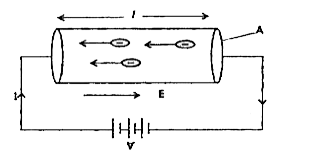Establish the relation between current and drift velocity?Solution in Punjabi
Drift velocity may be defined as that velocity with which a free electron in addition to its random motion gets drifted under the influence of an external field through the body of the conductor.
Relation between drift velocity and electric field : When an electric field is applied across the two ends of a conductor, the electrons possessing negative charge get accelerated in a direction opposite to the electric field. Due to this acceleration, the velocity of an electron increases, but it happens so only for a short time. It is because of the fact that the electron experiences random forces due to vibrating ions in the metal. Therefore, the electron may get deflected or scattered in a wide range of directions due to the action of random forces, Suppose that such a deflection takes place once in a time ton the average, called average relaration time. The velocity acquired by the electron due to external electric field in time equal to t is called drift velocity and it is imposed on the random velocity of electrons. If E is strength of the electric field applied, then
Force on the electron due to electric field = e E
Here, e is charge on electron. If m is mass of the electron, then acceleration produced is given by
a=eEm ...(1)
As the net velocity of an electron due to random motion is zero and the electron is accelerated for an average time τ , the additional velocity i.e., drift velocity acquired by the electron,
vd=0+aτ=aτ
From eqn. (1), substituting the value of a, we have
υd=eEmτ
where τ = average relaxation time.
Relaxation time. : The short time for which free electron accelerates before it undergoes a collision with the positive ion in conductor, is called a relaxation time.
Relation between drift velocity and current : Consider a conductor of length I and area of cross-section A.

Let V = Potential difference applied across the ends of the conductor
Let n = Number of free electrons per unit volume of the conductor
Al = Volume of the conductor
n Al = Total number of electrons in the conductor
Total charge on the conductor = q = (n Al) e ...(1)
Time taken by the free electrons to cross the length of the conductor,
t=lυd ...(2)
But I=qt
I=nAlellυd [Using (1) and (2)]
I=nAeυd
Topper's Solved these Questions
- BOOK - BETTER CHOICE PUBLICATIONCHAPTER - ELECTRIC CURRENT, RESISTANCE AND E.M.F.EXERCISE - LONG ANSWERTYPE QUESTIONS8videos
ELECTRIC CURRENT, RESISTANCE AND E.M.F.
- BOOK - BETTER CHOICE PUBLICATIONCHAPTER - ELECTRIC CURRENT, RESISTANCE AND E.M.F.EXERCISE - NUMERICAL PROBLEMS54videos
ELECTRIC CURRENT, RESISTANCE AND E.M.F.
- BOOK - BETTER CHOICE PUBLICATIONCHAPTER - ELECTRIC CURRENT, RESISTANCE AND E.M.F.EXERCISE - MOST EXPECTED QUESTIONS14videos
ELECTRIC CURRENT, RESISTANCE AND E.M.F.
- BOOK - BETTER CHOICE PUBLICATIONCHAPTER - ELECTRIC CHARGES AND ELECTROSTATIC FORCE EXERCISE - NUMERICAL PROBLEMS (MOST EXPECTED NUMERICALS )6videos
ELECTRIC CHARGES AND ELECTROSTATIC FORCE
- BOOK - BETTER CHOICE PUBLICATIONCHAPTER - ELECTRIC FIELDEXERCISE - NUMERICAL PROBLEMS (MOST EXPECTED QUESTIONS)4videos
ELECTRIC FIELD
Similar Questions
Why are resistance connected in series ?
10:41View SolutionA battery of emf 10 V and internal resistance 2Ω is connected to parallel combination of two identical resistors of resistance R. Current in the circuit is 0.5 A. What is the resistance of each resistor ? Find the terminal voltage of the battery.
03:02View SolutionDefine SI unit of resistance.
03:33View SolutionDielectric constant of water is 80. What is its permittivity ?
03:27View SolutionA charged plastic spherical ball of mass 8.4×10−14kg is found to remain suspended in a uniform electric field of Entensity 5×102NC−1. Calculate the charge on the ball.
01:02:11View SolutionRelation Between Drift Velocity And Current
25:23View SolutionWhat is drift velocity? Establish a relation between current and drift velocity?
03:56View SolutionEstablish the relation between drift velocity of electron and current density in metallic conductor.
04:32View SolutionRelation between current density and drift velocity is _______
05:14View SolutionIntroduction, Drift Velocity, Relation Between Current & Drift Velocity
05:16View SolutionCurrent and Drift velocity and Relation between drift veloct and current
10:25View SolutionWhat is the relation between drift velocity and electric current?
06:09View SolutionWhat is a drift velocity ? Establish the relations between the drift velocity and electric current.
06:06View SolutionEstablish the relation between drift velocity of electrons and electric field applied to the conductor.
03:14View SolutionWrite the relation between drift velocity and electric current.
View SolutionEstablish the relation between drift velocity of electron and current density in metallic conductor.
06:42View Solution

